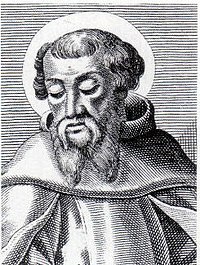Saint Boniface was a leader in taking the faith from Anglo-Saxon England to France, Netherlands, Belgium, Switzerland and western Germany in the 700’s. He helped shape Christianity in Western Europe.
Boniface’s birth name was Winfrid. It is believed he was born around 675, near Devon, England. Because he came from a wealthy family, while young, he attended a monastery school. He received more training at the Benedictine monastery. He taught at the abbey school until at age 30 he became a priest.
In 716, the abbot of his monastery died. It was expected that he would become the abbot. Instead, he decided to take a missionary trip to what is now the Netherlands. He was in his 40’s and gave up a safe life, to become a missionary in sometimes dangerous foreign lands. He spent a year where Willibrord, had been working since the 690’s. When a war broke out there, Willibrord returned to the abbey he had begun and Boniface returned home in defeat.
The next year Boniface returned to the European continent. He went straight to Rome. He asked Pope Gregory II for a mission and church support. The pope gave him the name Boniface. He is named after a martyr Boniface of Tarsus. He also appointed Boniface as a missionary to Germany. He became a bishop without a diocese because the Church there had no organization yet. He would never go to England again.
One story says Boniface chopped down a tree the German pagans worshiped to Thor. As he started to chop, a sudden burst of wind, a miracle, blew the ancient tree down. The tree split into four parts which fell to the ground in the shape of a cross. The pagan god didn’t strike Boniface down. The people became Christians. He used the wood from the tree to build a chapel named for Saint Peter.
He was good at starting new churches. He was asked to continue to help reform the Church. He sent many letters to the Pope in Rome. It helped him reform the Church in Germany. It helped form a strong bond between Rome and Europe.
When Boniface was 73, he was going back to the Netherlands on a new mission. He and his companions were attacked by enemy bandits. His companions wanted to fight back. Boniface told them to trust God. All were martyred.
 martyred during the persecution in Lyons. He wrote five books which explain how the heresy of the gnostics was different than the faith. Gnostics believe the world was made by an imperfect spirit.
martyred during the persecution in Lyons. He wrote five books which explain how the heresy of the gnostics was different than the faith. Gnostics believe the world was made by an imperfect spirit. 
 is parents were wealthy, lesser nobility. So he was educated at the local Catholic school. When he was 15, he joined the Augustinians. In 1212, he was transferred to an Abbey further away from his home. While there, he studied theology and Latin.
is parents were wealthy, lesser nobility. So he was educated at the local Catholic school. When he was 15, he joined the Augustinians. In 1212, he was transferred to an Abbey further away from his home. While there, he studied theology and Latin.